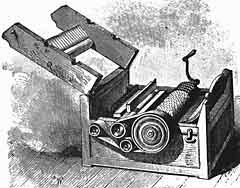
It’s winter squash season, which means it’s finally seasonally relevant to share my trick – hack, if you will – for cleanly and easily removing seeds from pumpkins, butternut squash, kabocha, and all other manner of hard-sided gourds. Every year I wonder whether someone else will share this trick, and yet somehow no one has. I figured this out so long ago that original Good Eats was still going strong and I seriously considered writing to Alton Brown and sharing it with him in case he ever did a pumpkin/hard squash episode – the show has since ended, taken a decade-long hiatus, and been revived, and still, Alton Brown, inventor of the kitchen hack, has not developed his own version of this trick. And my method even has a historical component, and for once it has nothing to do with medieval or Mediterranean history. Weirdly enough, I thought of it while I was in a high school history class learning about slavery.
Back when I was in 11th grade and taking US history, I was reading about the cotton gin and its role in industrializing slavery. Because I was a studious future historian of STEM, I was really interested in my very boring textbook’s explanation for what the cotton gin was and how it worked. The story went that the cotton gin mechanized cotton production for the first time in an effort to make slavery irrelevant to at least one part of the cotton production line, but had the opposite effect because plantation owners were greedy and had no concern for human welfare. I’m not going to say this narrative is false, but it’s not really accurate, in that the invention wasn’t really intended to help the plight of the enslaved, but to turn a profit. The problem with American cotton was that it had sticky seeds that were totally enmeshed in the cotton fibers. But this was a problem unique to American cotton, because Indian and Egyptian cotton (oh, wait, there’s the Mediterranean connection. whatever.) had slippery seeds that were easy to remove. So there was already a cotton gin for that kind of cotton – the tufts of fibers were fed through hand-cranked rollers and the seeds just popped out.

Eli Whitney’s cotton gin, image courtesy of the Eli Whitney Museum, eliwhitney.org
But when American cotton was fed through those rollers, they would just crush the seeds. Eli Whitney’s invention was to create large-weave mesh rollers, so the little wires of the mesh would surround a seed from all sides and pop it up into the roller. Once there was no need for the seeds to be manually removed, production could speed up and the American cotton industry could compete with Egypt and India, dooming more people to back-breaking field labor under the yoke of slavery.
So because I was some kind of nerd, after reading this my first thought was seeing it in action as part of a cooking project. The description of sticky cotton seeds reminded me of pumpkin seeds, and, conveniently, Thanksgiving was coming up, when my mom and I would make a metric ton of butternut squash soup. And because I was very into homey cooking and using up all my ingredients, I wanted to roast some squash seeds. But it bugged me that when you scoop out the seeds with a spoon all this sticky squash webbing comes with it. The webbing doesn’t come off afterward and it makes the seeds too wet to roast as nicely. So I took a whisk, stuck it into a squash, twisted, and lo and behold the seeds popped right out!
Here it is, step by step:

For varieties of squash with a long neck, separate this part from the round base where the seeds are.

Set the base on the cut end or its sturdiest side, then split it in half.

Hold the half over a bowl, insert the end of a whisk, and twist to pop out the seeds. Some seeds will loosen but hang by a thread, in which case you can use the edge of the whisk to scrape them into the bowl.

You’ll be left with just pulpy squash guts.

Scrape the pulp out with a spoon and then peel the squash to cut it up, or roast it whole.

Spread the seeds on a sheet pan with a protective layer such as this silpat, parchment paper, or aluminum foil. Sprinkle with salt – no oil necessary since the seeds are tacky enough for the salt to stick.

Roast at 350* for 10-20 minutes depending on the size of the seeds. They are done when they look dry and are just starting to brown at the edges. I did these in the toaster oven aka the best kitchen appliance!

Happy toasty squash seeds!
Let the seeds cool before scraping them from the pan and using as you like. If you want to get adventurous, there are now tons of recipes for adding spices and other interesting flavors to your pumpkin seeds before or after roasting, but personally I’m a purist.

[…] * Fair warning about prepping hard winter squash: they have a very sticky residue that will get on your knife and hands, so make sure to wash both with soap immediately after handling or you’ll end up with some weird peeling. For details about how to safely prep a squash, see my post about pumpkin seeds. […]
LikeLike